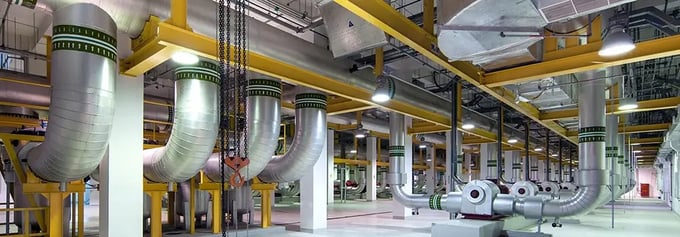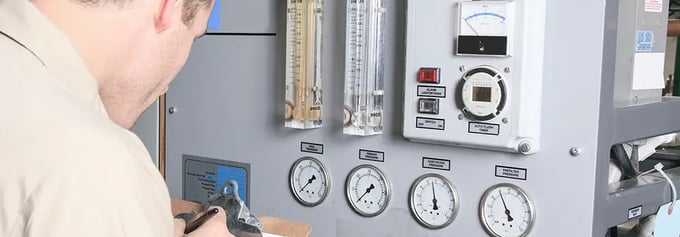Data centers play a crucial role in storing, processing, and managing the vast amounts of data created by businesses and people. Usually large facilities, data centers are usually large facilities are equipped with computer systems, storage devices, and networking equipment that are designed to meet the demands of modern life. And because of all this equipment, it's particularly important to minimize water leaks in data centers - the cost of damage and downtime can be phenomenal.

Facilities managers are responsible for the integrity of the physical infrastructure around the computer equipment in data centers. Key digital infrastructure relies this equipment being able to run, uninterrupted.
A typical mid-sized data center contains thousands of servers, and rows of network equipment, which produces a lot of heat. To dissipate this heat, a vast network of water-cooling pipes is used.
However, these pipes leak water, which can cause significant damage to equipment and data. Further risks come from roofs, HVAC systems, and external flooding - all of which increase your risk of damage and downtime.
To be successful, it's crucial that facilities managers put measures in place to prevent water leaks, and detect them early when they occur.
This article will cover four topics:
- Sources of water leaks in data centers
- The impact of water leaks
- Ways to prevent water leaks
- How to detect water leaks before they cause significant business impact
Where do water leaks occur in data centers?
Data centers come in different sizes and types. No matter which one you manage, there are four main causes of water leaks.
-
Cooling system failures: These systems use large amounts of water to remove heat from the servers and other equipment. Any part of the network can fail: pipes can burst, damaged valves can leak, and clogged drains an overflow. When this happens, water will leak and cause damage to surrounding areas.
-
Faulty HVAC systems: HVAC systems are responsible for regulating temperature and humidity levels in data centers. But industrial condensers may cause water to build up, pipes may not be connected correctly, and water can starts to drip. In addition to creating pools of water, the dripping can lead to unnoticed corrosion of critical infrastructure.
-
Roof leaks: Flat roofs are typical in industrial settings due to their attractive low cost and maintenance at scale. However, they are prone to water pooling, and damage - particularly around flashing. Not only does the water damage the roofing structure, but when it leaks, it can also damage the servers and other equipment below. And when this occurs, it's a serious safety hazard for onsite staff.
-
Natural disasters: Data centers are large, and need large plots of land to accommodate them. They're often built on cheaper land in more remote locations, and sometimes close to natural water sources, which are prone to flooding. This puts the data centers at risk of flooding, with water entering the building and causing damage to equipment and data. Furthermore, it takes facilities teams more time to travel to data centers located in more remote areas, meaning any water leaks detected will have more time to escalate.

The devastating impact of water leaks on a data centers
Water leaks have a significant impact on data centers. One of the primary impacts of water leak damage in a data center is the potential loss of critical data.
Interruption of business is damaging for customers - but data loss can be catastrophic. The impact on the data center is major: significant financial losses, reputational damage, loss of customer trust, and loss of future business.
Of course, water leaks don't always lead to loss of data - but fixing leaks and repairing any damage is still a time-consuming and expensive business. The leak must be fixed, any dampness eradicated, and repairs must be made to the building. Equipment may need to be moved or replaced, both during and after the repairs process.
In addition to the more direct impact of water leak damage, data centers may also face long-term consequences: if left untreated, dampness can cause mold growth and other environmental hazards. This can have an adverse effect on the health and safety of data center employees.
As a facilities manager, it is essential to have measures to prevent and detect water leaks. Early detection minimizes the potential impact on critical data. This helps to ensure the data center operates smoothly.

How to prevent water leaks in data centers
To prevent water leaks in data centers, it's important to take a multi-pronged approach:
-
Explore alternative cooling methods
Air-cooled systems use fans and heat sinks to dissipate heat. They reduce water consumption and processing, and help to minimize the risk of water leaks.
But while air-cooled systems eliminate the need for water-based cooling systems, they are more expensive to install and maintain. And they're also less efficient at dissipating heat.
-
Install and maintain equipment carefully
Taking extra care to install HVAC and plumbing properly pays significant dividends. Regular, planned inspection and maintenance of HVAC systems, plumbing, and roofing will also help to prevent water leaks by identifying areas that need servicing or repair. Maintenance should include cleaning the HVAC system, checking for leaks in the plumbing, and inspecting the roof for damage.
In reality, few facilities management teams have the necessary capacity to manually inspect and maintain all infrastructure on a sufficiently frequent basis. And manual inspections just aren't that reliable - even the most careful inspector can miss small cracks, particularly if they're busy.
How to detect water leaks in data centers before they become catastrophic
The harsh reality is that even the best maintained data centers will experience water leaks. And most data centers have solutions that remotely monitor and alert facilities managers to water leaks.
But standard solutions aren't sufficient for data centers, where even a small leak in the wrong place can cause significant damage and downtime. Data centers demand early detection of water leaks in order to avoid a tiny leak that can be quickly fixed, turning into a catastrophic event.
Data centers merit early water leak detection solutions that can detect as little as a couple of drops of water - detecting leaks in their infancy, well before critical equipment and infrastructure are put at risk. This enables facilities managers to repair leaks quickly, further minimizing risk of damage and downtime - and impact to the business' bottom line.

LAIIER's early water leak detection solution
At LAIIER, we believe that early water leak detection is key to minimizing damage and downtime. Our commercial water leak detection solution is capable of detecting leaks as small as a couple of drops of water, offering early leak detection suitable for sensitive environments such as data centers.
Interested in exploring how LAIIER can help you minimize risk and contribute to the operational efficiency of your data centers? Please book a call for a no-obligation conversation.